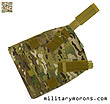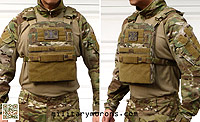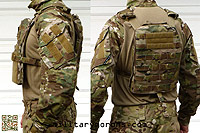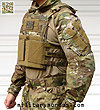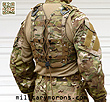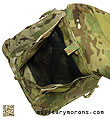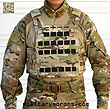CRYE PRECISION PAGE 1 PAGE 2 PAGE 3 PAGE 4 PAGE 5 PAGE 6 PAGE 7 PAGE 8
TO VIEW FULL SIZE IMAGES: USERNAME and PASSWORD are both "mm"
Crye Precision AVS (Adaptive Vest System)
| 6/1/13 - The Crye Precision Adaptive Vest System (AVS) is a complete system that enables the user to combine items to configure anything from a low-vis rig to a fully armoured load-bearing vest. The entire system is modular and designed for quick and easy switching of components to meet different threats and mission requirements. It was shown earlier this year at the SHOT Show and was recently released for sale. Overview - The Crye AVS (as described by Crye) fills the niche between the JPC (Jumpable Plate Carrier) and the CPC (CAGE Plate Carrier), offering a product that balances the light weight of the JPC with the load bearing capacity of the CPC. It's more than just another plate carrier that falls in between those two models; it's a fully configurable system made up of individual items from which the end user can pick and choose to assemble a rig that best suits his needs. The components are sold separately, so that the customer only need purchase what he anticipates he may need. AVS system components are available in MultiCam, Black, Coyote and Ranger Green. Note: Because the AVS is quite an extensive system, I'm writing this review in a few parts, due to limited time. Also note that while there is the recommended way to combine and assemble the different AVS components together, Crye states that the individual user can come up with his own configurations and ways to assemble the components that may work just as well.
|
| Part 1 - AVS Plate Carrier Configuration It its most basic form, the AVS Plate Carrier Configuration consists of:
Front Plate Bag- The AVS platebags are sold as a set (front and back), and are a custom fit for each plate size. The plate bags are available for different plate sizes (Sm, Md, Lg, Xl) and will accommodate most 'operator cut' plates and standard ballistic inserts. The front AVS plate bag is made from a combination of materials, but is mostly constructed of 500D Cordura. The sides of the front platebag incorporate stretch woven fabric, which ensures that plates of different thicknesses, and level IIIA soft in-conjunction inserts can be accommodated while keeping the fit snug. The The Standard Platebags are shown here which are sized to fit SAPI or stand-alone operator cut or swimmer cut plates. The back of the platebag is lightly padded for comfort, and there's also a stiffening insert inside that extends about half way up the platebag. The front platebag opens at the bottom for insertion of the plate with a Velcro-secured flap. The plate is inserted with the soft armour backing panel behind it (if needed). The MBAV platebag has seperate compartments for the plate and soft armour panel. The flap is then tucked under andb secured inside with velcro. The AVS platebag also differs from the platebags on the CPC and Chassis as it doesn't have an integral front flap. Instead, it has a large loop velcro field covering the bottom half of the front. This velcro field is for securing front flaps, straps or cummerbunds. Behind that velcro field is a kangaroo pocket with a row of webbing/velcro right above it. However, it doesn't have the internal dividers for magazines that the CPC and JPC kangaroo pockets have. Instead, it is lined with velcro internally to which different removable front panels can be secured with. More on this later. On the upper portion of the front plate bag is a an 'admin pocket'. It spans the width of the platebag, and is closed with velcro along the top. It has four elastic loops inside. It's not a very deep pocket, at only 4.3" deep, so longer items might stick out the top. I use it to store small items like a multitool. There are also two rows of PALS webbing on the front of the pocket, with velcro covering the center portion for patches/ID. Two vertical loops of 3/4" webbing on both sides of the front top velcro field are for attaching comms gear. A shoulder strap is sewn at each of the upper corners of the front platebag. The strap has loop velcro on the front and hook velcro on the back. The straps can either be connected to corresponding straps on the rear platebag, or used to connect to the AVS harness when folded down and secured to the back of the front platebag. There are also two 'slots' on the back of the platebag - and these serve multiple purposes which will become clear later. The bottom row of webbing on the back of the front platebag is for attaching an armoured groin protector (the LAP panel).
Rear Platebag- The rear plate bag is of the same construction as the front plate bag - 500D and stretch woven fabric. The sides of the rear plate bag are made of stretch-woven fabric, just like the front plate bag. It's very similar in design to the CPC rear plate bag. Note that the AVS platebags are not interchangeable with the CPC and Chassis platebags, to the best of my knowledge. The rear plate is inserted into the rear platebag through a bottom opening with a padded Velcro flap. There is a pull tab in the middle for dropping the plate if necessary. Like the front plate bag, the rear has a stiffener inside it between the back of the plate and the body and is also lightly padded. Instead of the rubber-covered drag handle of the Armoured Chassis, a lighter weight webbing drag handle secures flat with Velcro when not in use. While not as comfortable as the Chassis drag handle, it presents a lower profile. The outside face of the rear plate bag is covered in MultiCam PALS webbing and has a loop Velcro field at the top of the bag. There is a heavy duty zipper on either side of the plate bag for attachment of specialty rear-mounted accessory panels. On the inside face of the rear plate bag, there are two vertical rows of webbing on each side, and a center one. The outer two provide attach points from straps or cummerbunds and also to the AVS Harness. The central row is part of the rear lacing system. A small slot pocket near the bottom inside of the rear platebag is for stuffing the loose end of the lacing in there. The two shoulder straps sewn to the upper corners of the rear platebag serve the same function as those on the front platebag.
Shoulders and Side Straps - The platebags come with a pair of shoulder strap covers. They allow the front and rear platebags to be used as a minimalist plate carrier. The single side straps are not supplied with the Platebags, but come with the AVS Harness. They're supplied with metal sliders, and the side straps are simply connected to one of the many webbing loops on the rear platebag - you pick the one that best suits the height you want the straps to be. The side straps have loop velcro on the front and hook velcro on the back. The velcro on the shoulder straps on the front and rear platebags are overlapped and secured. Ride height adjustment is made by varying the amount of overlap. The shoulder strap covers pads are then wrapped around the shoulder straps. They have cable or hydration tube routing loops, which should face to the outside when installed. To don the single strap plate carrier, it's just lifted over the head and the side straps brought around to the front and velcro'd down to the velcro field on the front platebag.
Cummerbund - There are two cummerbunds currently available in the AVS system: the AVS 2-Band Skeletal Cummerbund and the AVS 3-Band Skeletal Cummerbund (shown here). Both cummerbunds come in S/M or L/XL sizes. They feature Crye's patented Skeletal/AirLite cummerbund design. The distinctive and unique AirLite cummerbund is a skeletonized version of a PALS-covered panel. It's missing the base fabric sheet and instead, the PALS webbing 'stand alone' by themselves, leaving the rows between them open. Each row is made up of two pieces of webbing with a thin stiffening material sandwiched between them. This adds stiffness for supporting pouches. On the inside, the center row of webbing is covered in velcro which helps secure the side plate pockets. The skeletonized design of the AirLite cummerbund allows pouches to be mount on the outside and inside of the cummerbund, while shedding unnecessary weight and bulk, and improving ventilation. The AVS 3-Band Skeletal Cummerbund is shown below. Both the 2 and 3-band cummerbunds attach to the AVS platebag the same way. On the inside of the rear platebag, there are two vertical rows of webbing slots on each side. The metal tri-glide buckles are removed from the ends of the cummerbund, and the cummerbund rows are routed through the vertical webbing slots. The provided elastic shock cord is laced through the cummerbund in a zig-zag fashion. The cord may be routed through any set of cummerbund rows for different girth adjustments. The cord is then tied into a knot.
Donning/doffing - The cummerbunds are brought around to the front and positioned on the front plate bag. Initial adjustment entails figuring out the ride height desired, and adjusting the overlapping velcro surfaces on the shoulders, and girth adjustments, accomplished by loosening or tightening the shock cord lacing at the back. The shock cord can be laced different ways to make smaller adjustments. I adjusted the girth so that when worn with a t-shirt, it's snug, but not tight. This way, I can put it over a thicker layer, like a jacket, and utilize some of that stretch in the shock cord. The amount that the cummerbund overlaps the front platebag can also be varied to make it tighter or looser. Observations and notes - The bare bones AVS in plate carrier configuration is relatively low profile, adding a bit more than the thickness of the plate. It's a trade-off, as the added thickness is due to the thin padding and PALS webbing, but those add comfort and utility. For an even lower profile, the shoulder pads can be left off. The 2 or 3-Band cummerbunds do add to the stability of the carrier by preventing movement of the front and back plates relative to each other. That being said, if the single side straps are positioned high enough, that will help limit movement of the plates. The AVS Harness is a primary base component of the AVS and provides structural support and a mounting platform for a variety of AVS components, allowing the user a wide range of different load-outs and configurations. The AVS Harness is available in sizes S, M, L and XL; and in MultiCam, Coyote, Black and Ranger Green. The AVS harness is made up of a left panel and right panel, that extend over the shoulders and around the sides. They're connected by a zigzag pattern of elastic shock cord, which allows the harness to be adjusted, and also have a little 'give' during movement. The AVS harness is similar in a sense to the Crye CPC (CAGE Plate Carrier), but trimmed down. Like the CPC, the AVS Harness flanks are semi-rigid, and molded/shaped to conform around the users body. The pieces enclose non-removable plastic stiffening panels that provide the rigidity for load bearing and the use of the StKSS system. The AVS harness does not provide any ballistic protection. The sid arms are narrower than the sides of the CPC - they're only about 3" tall. One difference between the AVS harness and the CPC is that the shoulders and flanks are all one piece on the harness. On the CPC, the shoulders are separate pieces from the flanks. Like the CPC, having the left and right panels split in the front and back allows the AVS to be donned and doffed like a regular front-opening garment without having to put it over the head, and width adjustments can be made by moving the panels closer or further apart from each other in the back. The AVS harness can be set up a number of ways. The harness arms (the part of the panels which extend around the sides) have flaps to which the outer PALS webbing is sewn to. These flaps are actually velcro'd down to the arms, and can be opened up. These flaps can be used to attach the harness arms semi-permanently to the front platebag by running the outer harness strap over the inside slots of the front platebag. When no cummerbund is used, the flaps are opened away from the harness arms, and the harness arms inserted into the slots on the inside of the front platebag. The flaps are then secured over the front platebag on the velcro field. On the rear of the AVS harness are straps and loops for the shock cord adjustment, as well as the rear platebag attachment and emergency doffing cable. Metal D-buckles are sewn at the top for attachment of the rear platebag. There are also three metal 1" loops on each side for routing the cummerbunds (single strap, 2-band or 3-band). I've attached the single strap to the middle metal loop in the rear in the photos below. The inside surfaces of the AVS harness is lined with the same soft, Velcro-compatible material as on the CPC and Chassis. The inside of the AVS harness feels like it's very lightly padded. The harness is supplied with two shoulder covers, which are made of stretch fabric and cover the shoulder of the harness. They have velcro loops on them for cable/hydration tube routing. The shoulders are covered in velcro, to which one of the straps from the front platebag secures. The other shoulder is attached to the platebag with a side release buckle. This can be installed on the left or right shoulder. I've installed it on the right side to minimize any interference with a rifle butt.
AVS Harness Non - Releasable Cummerbund Configuration - I've illustrated the AVS harness here with the single strap cummerbund on the right side, directly attached to one of the metal loops in the rear, and the arm flap on the left side secured to the front platebag. This is the non-releasable set up, and requires the right side strap to be unsecured from the velcro to open the right side up. Both side arms are inserted into the slots behind the front platebag first, then the strap and flap secured to the velcro field in front. The Harness can also be worn without side straps or cummerbunds; both flaps on the harness arms are opened away from the harness arms, and secured in front of the front platebag.
AVS Harness Releasable Cummerbund Configuration - The AVS harness can be set up so that the cummerbunds are releasable. This applies to the single side strap, 2-band and 3-band cummerbunds. An emergency doffing cable comes with the AVS Harness, and only one is needed for the setup since only one shoulder has a side release buckle. The emergency doffing cable is a stainless steel cable covered in plastic, with a loop at one end with a velcro tab for securing it. The cable is first routed over the shoulder and upper back through loops and channels. The shoulders are then covered by the shoulder covers. The three webbing ends of the cummerbund are inserted through the metal loops on the back of the harness, while the emergency doffing cable is then routed alternately through the rubberized loops and the cummerbund webbing rows, then the end is tucked into a rubberized fabric pocket at the bottom of the harness flank. Note that the metal tri-glides on the cummerbund need not be on the cummerbund for this setup, but I left them on there so they wouldn't get lost. For a non-releasable setup, the metal tri-glides will be placed on the other side of the metal loops on the harness, to retain the webbing ends of the cummerbund. The cummerbund's girth can be adjusted by choosing which loops on the end to route the cable through. The loose webbing ends of the cummerbund are tucked behind the rear plate when it's installed.
The small tab on the loop end of the emergency doffing cable secures it to the velcro on the shoulder. When the loop is pulled down and forward, the cummerbund is released in the rear, opening up the side of the AVS. The side release buckle on the shoulder still needs to be released. In the photos below, I've installed emergency doffing cables on both shoulders, but the one on the right is the more functional one since the shoulder release buckle is on the right.
AVS Rear Platebag Attachment - On the rear of the AVS harness are two metal D-buckles near the shoulders, and two attachment tabs with snaps on the back. The rear platebag is attached at the shoulders first. The rear platebag is first placed face up (label up) if you're facing the rear of the harness. The shoulder straps from the platebag are then routed through both metal D-buckles. The buckles are split apart (they're two pieces), and the strap is routed back towards the platebag. The strap can be folded in half longitudinally to help it pass through the buckle. The strap is then routed under the webbing on the rear of the platebag and attached to the velcro. Ride height for the rear platebag is determined by adjusting the placement of the straps. Filpping the rear platebag over (label down) towards the back of the harness, the attachment snaps are unbuttoned. The stiff attachment tabs on the harness are routed through the appropriate slots on the platebag, and the snaps secured. This is repeated for the other side. The rear platebag rides on these tabs, which allow some lateral movement when the shock cord lacing on the harness is adjusted.
The Adaptive Vest System is a available with a variety of accessories, designed specifically for the AVS. All components are available in MultiCam, Coyote, Black and Ranger Green. As mentioned previously, the most basic configuration of the AVS would be a simple plate carrier with single strap or cummerbund, and no harness. From the basic plate carrier, the user can purchase, mix and match the different AVS components to suit his needs. Here's a list of available AVS components, current at the time of writing:
I don't have all the system accessories, so I'm illustrating here what I have on hand, in addition to those I've shown above. AVS Detachable Flap, M4 - This attaches to the front AVS platebag, and holds three M4 mags. The flap is a flat panel with hook velcro on the back side to interface with the loop velcro field on the lower front of the front platebag. It has three seperate magazine pouches with elastic retention and long velcro-secured flaps, which each hold one 30-round M4 magazine. They're designed for USGI mags but will fit Pmags as well. They're a little tight with TangoDown ARC mags, but they'll still fit. To install the flap to the front platebag, the flap is flipped over and placed over the front of the carrier with the four attachment straps oriented down. The attachment straps are routed through the webbing slots above the slip/kangaroo pocket on the front platebag. The straps are then pulled down until the top of the panel is at the top edge of the slots. The slip pocket on the front platebag is opened, and the panel attachment straps laid down flat and secured inside the pocket. The slip pocket is closed and the panel flipped down. The panel is flipped up when cummerbunds or straps are secured to the velcro field on the front of the platebag, then flipped down again to secure them. The tab and snap at the bottom secure the flap to the front platebag.
AVS Low Profile Belt and StKSS Load System - The AVS Low Profile Belt is very similar to the Low Profile Belt I previously featured with the Crye CPC. The AVS Low Profile Belt is essentially a non-ballistic version of the Blast Belt, but without removable sleeves on the sides and not quite as tall in the back, as it is designed for load bearing rather than ballistic protection. The Low Profile Belt consists of the outer shell, and inner web belt, and the foam/stiffening insert. The insert is sewn into the belt so it's not replaceable with a ballistic insert. The outer shell is made of 500D Cordura and has two rows of PALS webbing on the side and rear sections. The PALS sections form sleeves through which the inner belt is threaded. The rear section forms a flap at the bottom which can be opened up to remove or install the insert. Behind the PALS webbing on the sides, are slots which are part of the StKSS system. The inner web belt is made from 2" webbing and has a plastic stiffener. A non-slip dual-adjust buckle is used - the buckle prevents webbing slippage during movement, so the user doesn't have to keep tightening the belt. There is vertical elastic webbing sewn over the front belt loops. The stiffening insert makes the belt rigid, and it will not roll over under load. It's easily the most supportive MOLLE war belts available. The AVS Low Profile belt is lined with velcro-compatible material on the inside, and the comfort pads from the Low Profile Belt can be used on it as well. The main difference between the original Low Profile Belt and the AVS Low Profile belt is the reinforcement of the entrance to the AVS StKSS channels, with the addition of a row of webbing. Also, the PALS panels on the sides of the AVS belt have an opening at the bottom to allow access to the internal belt. That way, drop holsters that use belt loops can be hung from the internal belt without using a MOLLE adapter.
Crye's Structural Kinetic Support System (StKSS™) was first seen on their CPC, and is one of those things that designers strive for - amazingly simple, yet effective. It's a system that allows a wearer to selectively transfer some or all of the weight of his armour load vest to his hips. StKSS allows the wearer’s shoulders and spinal column to be completely isolated from the weight being carried. Instead, the weight is transferred directly to the pelvis (hip bone) and legs.The AVS Harness is shaped/semi-rigid, and is thus able to support the weight of the entire plate carrier. The StKSS utilizes a rigid support on each side that connects the AVS Harness and the AVS Low Profile Belt, with the ends attached to both pieces of equipment. The kits are available for the different AVS sizes (SM, M, L and XL), and include two different lengths for adjustment. My medium AVS is shown with the Medium StKSS supports. The support is a lightweight, very rigid carbon fiber flat rod, enclosed in webbing, with a retaining strap and snaps. The top end of the support with the MultiCam webbing is positioned on the harness side arm, and the webbing wrapped around it and secured with a snap. The AVS Low Profile Belt has slot pockets behind the PALS webbing that the bottom of the support slides into. The black retaining strap is woven through the PALS webbing to keep the support anchored to the belt. With the supports captured at each end, they 'fix' the distance between the AVS harness and the Low Profile Belt, just like a frame on a pack does with the shoulder straps and hip belt. The distance between the AVS and the hip belt is adjusted by swapping out the two different lengths of supports so that the supports push up on the AVS and offload some of its weight onto the hips. The belt should be centered on the hips, not around the waist, and be adjusted so that the center line of the belt rests on the iliac crests (hip bones). The supports can be installed onto the CPC, then inserted into the belt after donning them separately, or leaving the AVS and belt attached and the whole thing donned as a unit. When donned separately, the supports are inserted into the belt by first leaning to the side one way, then the other. The retaining strap is difficult to weave through the top loop of PALS on the belt with one hand once the support is inserted into the belt pocket, so it's usually left unsnapped. There's very little chance of the support slipping up and out of the belt as the pocket is deep. From feedback in the field, the preferred way was to keep the AVS and belt attached, and don them as a single unit.
AVS 6"x9" Side Plate Carrier Set - The AVS has two side plate carriers available; the 6" x 6" set and the 6" x 9" set shown here. These enable the user to 'up armour' the sides of the AVS with soft ballistic panels, hard plates, or both. The carrier is made of a combination of 500D cordura and stretch woven fabric. The carrier features and internal elastic strap to keep a 6" x 6" hard plate in place. There are two vertical strap loops on the outside and hook velcro that enable it to slide over the side arm of the harness. The fabric flap on the harness arm is peeled back and the carrier slipped onto the arm, then the fabric flap is re-secured over the straps.Crye states on their website that the 6" x 9" pouch set allows the use of their soft armour panel (6" x 10.5"), but when inserted, the ballistic panel is wavy because it is 1.5" longer than the carrier and very cramped in there. While the stretch fabric stretches, it doesn't stretch that much. I'm not sure why Crye didn't make it 10" instead of 9". I had a 6" x 8" panel that I was able to place in there, and that is what's shown below.
Pack Zip-on Panel - While rear zip-on panels are not part of the AVS system, the AVS rear platebag has the zippers on each side of the plate to accommodate them. There are three zip-on panels available; the MOLLE Zip-On panel, Pouch Zip-On Panel and the Pack Zip-On Panel. I covered the first two in my CPC writeup here. The Pack Zip-On Panel (medium shown) measures about 13" tall and tapers from 1)" wide at the top to 12" wide at the bottom. It's constructed out of a combination of 500D Cordura and stretch fabric. It comes in different sizes to match to the size of the rear platebag. The Pack Zip-On Panel attaches to the rear platebag via the side zippers and tabs with snaps which secure to the PALS webbing on the rear platebag. There's a full size hydration reservoir compartment behind the main compartment with a center hanger. An expandable 'tail' is stored inside the hydration compartment and extends to accommodate longer items like bolt cutters or a tall/slim hydration reservoir. The main flap has a 7" x 4" loop velcro field on the outside, and a zippered pocket for smaller items.
The main flap opens up to reveal the main compartment, which has an additional mesh pocket inside. The main compartment has a vertical zipper in the center which allows full access to the compartment when open. A tab with snap prevents the zipper from opening by itself. The zipper is necessary due to the tapered profile of the compartment - the opening would be too small at the top without it. The stretch fabric is utilized on the sides, which allow the pack to expand quite a bit to store larger/bulky items. Quite amazingly, I was able to fit a Crye Airframe helmet inside it. I'm thinking that the pack would be useful for sustainment items or additional protective clothing like the Crye insulated Halfjak. Obviously, access to the any of the Zip-On panels requires a team mate or doffing the AVS, but it provides additional load-bearing capability without the weight of a full pack with straps in a much more streamlined package. I use it for the hydration compartment mostly.
Part 4 - Set up, notes and observations Front opening options - As illustrated earlier, the AVS can be set up in a multitude of configurations, and this includes how the side arms of the harness actually connect/secure to the front platebag. It's really up to the end user to decide what configuration suits him best, and what side setup is used (single strap, two or three row commuerbund etc). Wanting to simply my setup and not needing the additional cummerbunds, I settled on the side strap attachment on the left side as my chosen closure. Shown below in the first photo on the left is the single strap non-releasable configuration, where the strap is attached directly to the metal loop on the harness. The second photo shows the single strap secured by the emergency doffing cable, which when pulled, releases the single strap in the rear and allows the harness side arm to slip out from the loop in the front platebag. The shoulder would need to be released by actuating the SR buckle. This attachment method, however, still requires that the AVS Detachable Flap on the front platebag be flipped up and down to don and doff the AVS, so that the single strap can be velcro'd to the front of the platebag under the flap. The AVS Detachable Flap has two tab loops on each side, to which slotted buckles can be installed. I decided to take advantage of this feature and use a slotted ITW SR buckle to facilitate donning and doffing of the AVS without having to lift the flap. I first installed the female buckle onto a length of 1" webbing (not the single strap, which has velcro), and the male portion directly onto the tab on the Detachable Flap. This is illustrated in the 3rd photo below. This worked very well, but I wanted to get rid of the side strap altogether, so I installed the female buckle onto an EMDOM T-ring adapter. I cut off the plastic D-ring, and installed the adapter and buckle onto the AVS harness side arm (4th photo below). To don the AVS, I slip the front of the arm into the loop behind the front platebag and engage the buckle. To doff, I release the buckle and the arm slips out. The only disadvantage is that there's no adjustability with the T-ring except by installing it forward or aft on the side arm in increments of 1.5". However, minor adjustments in girth can be done by loosening or tightening the rear shock cord lacing on the AVS Harness. Sling attachment - I don't like using a sling when wearing a vest, as slings usually ride up onto my neck and get in the way of pouch access etc, so I typically use the EMDOM URS (Universal Rig Strap). It functions as a single point sling and is attached directly to the rear of the rig and routed over the support side shoulder, so that when the rifle is hanging, it's on the support side and out of the way of the handgun. I attached the URS to the rear platebag of the AVS as shown below, with the URS routed over the shoulder strap and inside the shoulder cover. Notes and Observations - Earlier this year at the SHOT show, when I spoke to Caleb and Gregg at the Crye booth about the AVS, they described it as 'somewhere in-between the JPC and the CPC'. After wearing it at range sessions between February and May, I'd say that that's a pretty good description. Depending on the configuration, the AVS fills the gap between the ultra light weight JPC and the more supportive CPC for heavier loads. Without the removable comfort pads available on the CPC and Crye Chassis, the AVS sits closer to the body and is therefore at little less bulky than the CPC or Chassis. With the use of the semi-rigid AVS Harness, the AVS offers load support that the JPC doesn't, and compatibility with Crye's StKSS load system. I set up my AVS without the cummerbund, as I had no need for the releasable feature, and could direct-attach pouches to the PALS webbing on the side arms of the harness if need be. Being just a range setup, I usually keep the sides of a rig slick to minimize bulk, and instead put pouches on my belt. While not a 'real world' load out (I'm not a 'real world' guy anyways), I do the same for most of my range sessions where I try out different gear, so it's more of a direct comparison. The SR buckle release I rigged up on the side enabled me to don and doff the AVS without having to lift up the front flap. I didn't have to mess with straps or velcro, and found it more convenient and simpler. When donning rigs with front flaps, I always have some difficulty lining up the cummerbund and have to adjust it a couple of times before getting it right. Being a smaller fellow, I appreciated the close fit of the AVS and reduced bulk from the Chassis and CPC, especially when shooting in prone or other positions where more flexibility/mobility is desired. I'm usually using the JPC, as it offers the lowest profile out of all my plate carriers and is also the lightest and most 'mobile'. The AVS, as mentioned before, is in-between the JPC and CPC, but can carry a heavier load more comfortably than the JPC, which has minimalist shoulder straps and no semi-rigid support like the AVS harness. The rear shock cord adjustment, which is also present on the JPC, CPC and Chassis, gives the user and additional method of girth adjustment besides utilizing the cummerbund overlap in the front. By having adjustment at the rear, the cummerbund and sides can be attached to the front platebag by the same amount every time, keeping the location of pouches and side plates consistent. The shock cord lacing also has slight 'give', so that the AVS can be snugged to the torso yet still allow the ribcage to expand when breathing heavily under exertion. With most plate carriers, the girth is fixed once you don them, and don't have the ability to expand slightly. This means that you sometimes have to wear them a bit looser to compensate for ribcage expansion, and then they're more prone to bounce when running or on the move. By utilizing the rear shock cord adjustment to snug up the AVS closer to the body, the whole rig feels more solid, and also helps distribute the load better. Using the StKSS with the AVS Low Profile Belt is much like using it on the CPC - the StKSS supports push up on the semi-rigid sides of the AVS, and reduce the load on the tops of the shoulders by transferring some to the hips via the belt. It's important to have the belt adjusted properly and the correct StKSS support length chosen. The belt needs to sit centered on the iliac crests of the pelvis, and snug enough such that it won't slip down. Having the belt on the hip allows it to be snug enough, whereas if it were worn higher around the waist, it'd be very uncomfortable and restrictive. The AVS belt can either be left attached to the AVS by the StKSS supports, or they can be detached from the belt and left on the AVS harness. Note that if you don them seperately, you probably won't be able to secure the StKSS support to the belt with the webbing strap and snap unless you do so before the belt is tightened around your waist as the PALS webbing will be too tight to thread the strap through when you wear it around your waist, plus there may be a pouch mounted at that location. The padding on the shoulders of the AVS is minimal, yet quite comfortable for a day's wear with front and back plate and soft inserts, side ballistic soft inserts, 3 mags in the front pouches and a full 100 oz hydration bladder in the Zip-On pack panel. Modular systems like the AVS System appeal to me because you start out with light weight and low profile base/core components then add and scale up as needed. Some non-modular armoured carriers have the side plate compartment and soft armour insert pockets incorporated into the sides or cummerbunds, and are non-removable even if you're not running side armour. The result is layers of nylon and velcro that add unnecessary bulk and weight. By having light weight pockets on the sides that slide over the harness side arms keep the bulk to a minimum. The smart use of stretch fabrics and lighter weight fabric in low-abrasion areas all contribute to bulk and weight reduction. The Crye JPC has been my favourite plate carrier for the range since it came out because of its low profile and light weight. Why wear a plate carrier at the range? Safety. Accidents happen, no matter how experienced the shooters. Anyways, the JPC has been dethroned by the AVS; which suprised even me, as it's just more supportive when loaded up and holds up the weight of my rifle when sling better, without much added bulk. If you were looking for a scalable plate carrier in between the JPC and the CPC, the AVS fits that niche perfectly.
|


